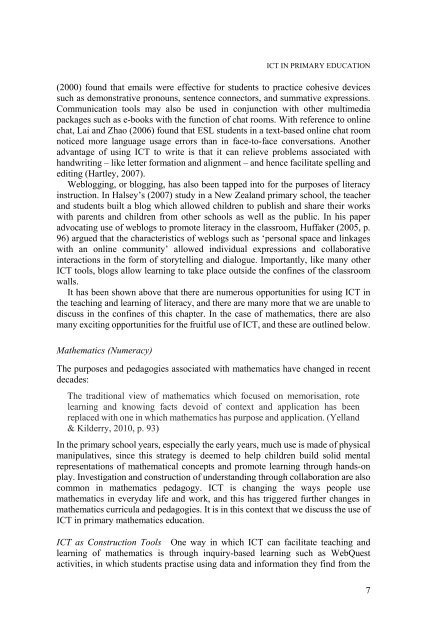1517-creating-holistic-technology-enhanced-learning-experiences
1517-creating-holistic-technology-enhanced-learning-experiences
1517-creating-holistic-technology-enhanced-learning-experiences
Create successful ePaper yourself
Turn your PDF publications into a flip-book with our unique Google optimized e-Paper software.
ICT IN PRIMARY EDUCATION<br />
(2000) found that emails were effective for students to practice cohesive devices<br />
such as demonstrative pronouns, sentence connectors, and summative expressions.<br />
Communication tools may also be used in conjunction with other multimedia<br />
packages such as e-books with the function of chat rooms. With reference to online<br />
chat, Lai and Zhao (2006) found that ESL students in a text-based online chat room<br />
noticed more language usage errors than in face-to-face conversations. Another<br />
advantage of using ICT to write is that it can relieve problems associated with<br />
handwriting – like letter formation and alignment – and hence facilitate spelling and<br />
editing (Hartley, 2007).<br />
Weblogging, or blogging, has also been tapped into for the purposes of literacy<br />
instruction. In Halsey’s (2007) study in a New Zealand primary school, the teacher<br />
and students built a blog which allowed children to publish and share their works<br />
with parents and children from other schools as well as the public. In his paper<br />
advocating use of weblogs to promote literacy in the classroom, Huffaker (2005, p.<br />
96) argued that the characteristics of weblogs such as ‘personal space and linkages<br />
with an online community’ allowed individual expressions and collaborative<br />
interactions in the form of storytelling and dialogue. Importantly, like many other<br />
ICT tools, blogs allow <strong>learning</strong> to take place outside the confines of the classroom<br />
walls.<br />
It has been shown above that there are numerous opportunities for using ICT in<br />
the teaching and <strong>learning</strong> of literacy, and there are many more that we are unable to<br />
discuss in the confines of this chapter. In the case of mathematics, there are also<br />
many exciting opportunities for the fruitful use of ICT, and these are outlined below.<br />
Mathematics (Numeracy)<br />
The purposes and pedagogies associated with mathematics have changed in recent<br />
decades:<br />
The traditional view of mathematics which focused on memorisation, rote<br />
<strong>learning</strong> and knowing facts devoid of context and application has been<br />
replaced with one in which mathematics has purpose and application. (Yelland<br />
& Kilderry, 2010, p. 93)<br />
In the primary school years, especially the early years, much use is made of physical<br />
manipulatives, since this strategy is deemed to help children build solid mental<br />
representations of mathematical concepts and promote <strong>learning</strong> through hands-on<br />
play. Investigation and construction of understanding through collaboration are also<br />
common in mathematics pedagogy. ICT is changing the ways people use<br />
mathematics in everyday life and work, and this has triggered further changes in<br />
mathematics curricula and pedagogies. It is in this context that we discuss the use of<br />
ICT in primary mathematics education.<br />
ICT as Construction Tools One way in which ICT can facilitate teaching and<br />
<strong>learning</strong> of mathematics is through inquiry-based <strong>learning</strong> such as WebQuest<br />
activities, in which students practise using data and information they find from the<br />
7


